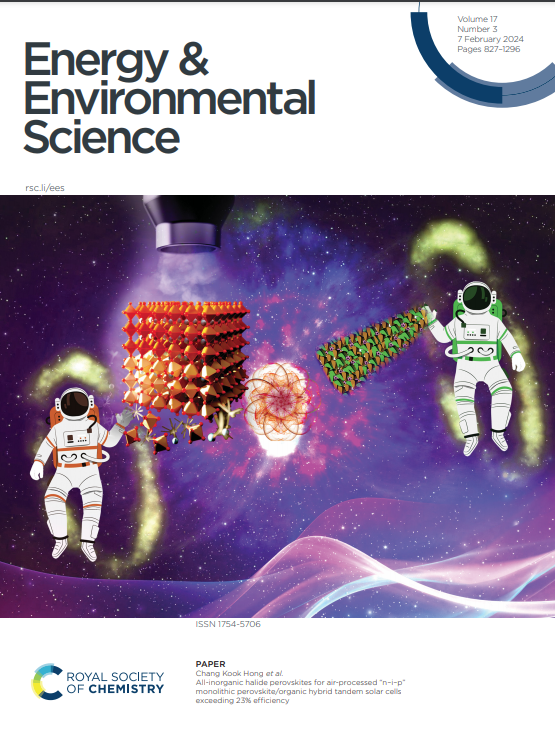Lithio-amphiphilic nanobilayer for high energy density anode-less all-solid-state batteries operating under low stack pressure
IF 32.4
1区 材料科学
Q1 CHEMISTRY, MULTIDISCIPLINARY
引用次数: 0
Abstract
Anode-less all-solid-state batteries (ALASSBs) offer unparalleled energy density and enhanced safety. ALASSB cells usually incorporate a protective layer on the anode current collector to stabilize lithium (Li) deposition, yet are liable to short-circuiting even at low current densities. Here we report a nanobilayer comprising tungsten (W) and magnesium (Mg) with a total thickness of 230 nm for anode protection. The upper lithiophobic (Li-insoluble) W layer induces highly dense Li deposits underneath through its high interfacial energy, whereas the lower lithiophilic Mg layer nucleates Li for uniform Li deposition. Even at room temperature and low stack pressure (2 MPa), an energy density of 1100 Wh L−1 and 71.9% retention after 300 cycles are demonstrated in a pouch-type full-cell. Furthermore, the effect of lithio-amphiphilicity is validated for other Li-insoluble metals, proving the versatility of the concept. This study unveils a simple yet effective approach for short-circuit-free cycling at high current densities, a challenging achievement for ALASSBs.用于在低叠加压力下工作的高能量密度无阳极全固态电池的锂两亲纳米薄膜层
无阳极全固态电池(ALASSB)具有无与伦比的能量密度和更高的安全性。无负极全固态电池通常在负极集流器上加入保护层以稳定锂(Li)沉积,但即使在低电流密度下也容易发生短路。在此,我们报告了一种由钨(W)和镁(Mg)组成的纳米薄膜层,其阳极保护层的总厚度为 230 纳米。上层疏锂(锂不溶)的钨层通过其高界面能诱导高密度的锂沉积在下面,而下层亲锂的镁层则使锂成核,从而实现均匀的锂沉积。即使在室温和低堆叠压力(2 兆帕)条件下,在袋式全电池中也能达到 1100 Wh L-1 的能量密度,并且在循环 300 次后仍能保持 71.9% 的能量密度。此外,对其他锂不溶金属的锂亲和性效果也得到了验证,证明了这一概念的通用性。这项研究揭示了一种在高电流密度下实现无短路循环的简单而有效的方法,这对 ALASSBs 来说是一项具有挑战性的成就。
本文章由计算机程序翻译,如有差异,请以英文原文为准。
求助全文
约1分钟内获得全文
求助全文
来源期刊

Energy & Environmental Science
化学-工程:化工
CiteScore
50.50
自引率
2.20%
发文量
349
审稿时长
2.2 months
期刊介绍:
Energy & Environmental Science, a peer-reviewed scientific journal, publishes original research and review articles covering interdisciplinary topics in the (bio)chemical and (bio)physical sciences, as well as chemical engineering disciplines. Published monthly by the Royal Society of Chemistry (RSC), a not-for-profit publisher, Energy & Environmental Science is recognized as a leading journal. It boasts an impressive impact factor of 8.500 as of 2009, ranking 8th among 140 journals in the category "Chemistry, Multidisciplinary," second among 71 journals in "Energy & Fuels," second among 128 journals in "Engineering, Chemical," and first among 181 scientific journals in "Environmental Sciences."
Energy & Environmental Science publishes various types of articles, including Research Papers (original scientific work), Review Articles, Perspectives, and Minireviews (feature review-type articles of broad interest), Communications (original scientific work of an urgent nature), Opinions (personal, often speculative viewpoints or hypotheses on current topics), and Analysis Articles (in-depth examination of energy-related issues).
文献相关原料
| 公司名称 | 产品信息 | 采购帮参考价格 |
|---|
 求助内容:
求助内容: 应助结果提醒方式:
应助结果提醒方式:


